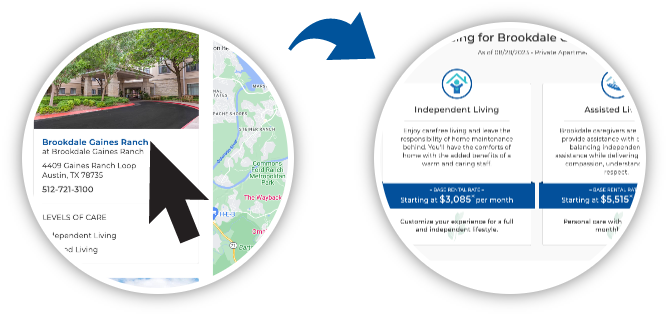- Home
- Brookdale Life
- Brookdale Blogs
- 6 Easy-to-Care-For Indoor Plants
May 18, 2020
6 Easy-to-Care-For Indoor Plants
1. Aloe Plant
Many of us have heard about the medicinal properties of these little guys, and they can also make great indoor plants if you know the right care techniques.
Care: pick a cactus potting mix when you go to plant one of these. Aloe plants need a decent amount of light, so make sure the pot is close to a window that gets plenty of sun. Make sure the pot they are planted in has great drainage because they don’t do well in standing water. When you go to water, drench the soil, and then wait until the soil is completely dry before watering again.
Watch for: if the leaves are wilting in the summer, it means the plant is being under-watered, and yellowed leaves mean overwatering.
2. Snake Plant
There are around 70 different species of snake plants, but the most common is Sansevieria trifasciata, or as some people like to call it, “mother-in-law’s tongue.” They can grow anywhere from 8-inches to 12-feet high!
Care: they don’t need a lot of sun, so indirect light is best. These are also great for people who forget about watering, because is best to wait until the soil is completely dried out, and they need even less water in the winter months.
Watch for: yellow, droopy leaves and a funny smell, which could mean it is being overwatered
3. Spider Plant
These fun plants are able to survive in a variety of light, but they do prefer direct sunlight. And you can tell when they are super happy, because they sprout little plant “babies”.
Care: for best growing conditions, place this plant near a window that gets bright, indirect sunlight. They will also tolerate low-light areas where other plants might not thrive. Water when the top two-inches are the soil are dry. Cut back watering in the winter, and make sure they aren’t exposed to cold drafts.
Watch for: droopy leaves can be a sign of underwatering, and yellow or soft brown leaves can mean overwatering.
4. Pothos
Also called “devil’s ivy” because they are tough to kill, these make for great hanging pots, and they don’t need to be pruned — although they will continue to grow. And grow.
Care: they don’t need a ton of light and only need to be watered sparingly. If the soil is too moist between waterings, the roots can rot.
Watch for: sad-looking leaves even after a watering can mean it’s time to repot, because the roots are too big for its current pot.
5. ZZ Plant
If you’re someone who claims to have no green thumb whatsoever, this plant is the perfect match for you. They don’t require much attention at all and survive in a variety of environments.
Care: the ZZ plant loves low light, so make sure to keep them away from direct light. And they only need water when the soil is completely dried out.
Watch for: yellow leaves mean the plant is getting too much water.
6. Air Plants
Recently, you’ve probably seen these popping up all over the place. They’re having a trendy moment right now. And there are all sorts of species and varieties. The cool thing about these is they don’t need soil to survive, but they do need a bit of attention to thrive.
Care: place them in the sink with enough water to submerge them, and let them soak for about a half hour. When you take them out of the water, turn them upside down on a towel to let them drain. Once they’re dry, put them back in their home. You can also mist them every few days to keep them looking fresh, especially in the winter when the humidity is lower. They also prefer shady spots, so keep them out of the sun’s rays. You’ll know when you plan is getting what it needs, because it’ll send up flowers. Once the flower dries out, snip it off and it will eventually make more blooms.
Watch for: allow air plants to dry out before returning to their homes. If the roots don’t have proper air flow, they will rot.
No matter what plants you pick, they’re bound to bring a bright spot to your home. Now the only question is, which one will you bring home first?
Source: naldc.nal.usda.gov/download/CAT87213641/PDF
Note: The above is shared for informational purposes only. We are not infectious disease experts and you should consult with trusted, independent, reputable sources before acting on any content on this website, especially if you have a medical condition or are at increased risk for contracting COVID-19. The content is not intended to be a substitute for professional medical or health advice. Never disregard professional medical or health advice or delay in seeking it because of something you have read on our site.
Categories
- Alzheimer's & Dementia
- Caregiver's Corner
- COVID-19
- Health, Safety and Wellness
- Financial Well-Being
- Passion & Purpose
- The Journey to Senior Living
- Trending Now
- Socialization & Relationships
- Brookdale Solutions
- Brookdale Vision and Growth
Archives
View All
- November 2025
- October 2025
- September 2025
- August 2025
- July 2025
- June 2025
- May 2025
- April 2025
- March 2025
- February 2025
- January 2025
- December 2024
X
Let us help find the right community for you!
Complete the form and a Senior Living Advisor will be in touch!
Inside Brookdale Communities
See what’s happening on our community Instagram pages
Brookdale has communities near you!


